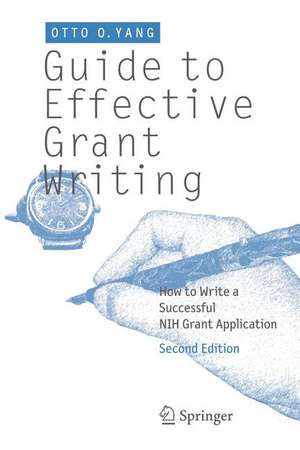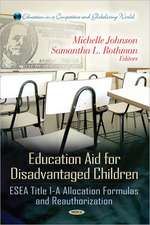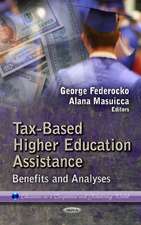Guide to Effective Grant Writing: How to Write a Successful NIH Grant Application
Autor Otto O. Yangen Limba Engleză Paperback – 12 iun 2012
Preț: 476.79 lei
Nou
Puncte Express: 715
Preț estimativ în valută:
91.23€ • 95.25$ • 75.51£
91.23€ • 95.25$ • 75.51£
Carte tipărită la comandă
Livrare economică 04-18 aprilie
Preluare comenzi: 021 569.72.76
Specificații
ISBN-13: 9781461415800
ISBN-10: 1461415802
Pagini: 106
Ilustrații: XIV, 90 p.
Greutate: 0.16 kg
Ediția:2nd ed. 2012
Editura: Springer Us
Colecția Springer
Locul publicării:New York, NY, United States
ISBN-10: 1461415802
Pagini: 106
Ilustrații: XIV, 90 p.
Greutate: 0.16 kg
Ediția:2nd ed. 2012
Editura: Springer Us
Colecția Springer
Locul publicării:New York, NY, United States
Public țintă
Professional/practitionerCuprins
Preface To The First Edition.- Preface To The Current Edition.-Overview: Overall Goals When Writing Grant Applications.- Organization And Use This Guide.- Preparing To Write.- Types Of Nih Grants.- Anatomy Of The Nih Grant Application.- Starting To Write: Deciding The Research Aims And Overcoming Writer’s Block.- Organization And Writing Style.- Figures And Tables.- Specific Aims.- Research Strategy: Significance.- Research Strategy: Innovation.- Research Strategy: Approach.- Bibliography And References Cited.- Appendices.- Collaborators And Consultants.- Training And Career Development Grants.- Administrative Sections And Submission Process.- Scoring Process.- Resubmitting An Application.- Non-Nih Grants.- Conclusions.- Appendix: Useful Web Resources.- Index.
Recenzii
From the reviews of the second edition:
“It is a very recent book gives most timely information. … This rule book narrates an insider’s view about the how an application is evaluated and what could be winning point in writing for grants. Author’s writing style along with illustrations provided will captivate readers’ interest from preface to conclusion. … As reader reaches the conclusion chapter the qualities like precision and clarity will become mantras to win the grant writing skill effortlessly!!” (T. S. Seemanthini, Journal of Psychosocial Research, Vol. 8 (1), January-June, 2013)
“It is a very recent book gives most timely information. … This rule book narrates an insider’s view about the how an application is evaluated and what could be winning point in writing for grants. Author’s writing style along with illustrations provided will captivate readers’ interest from preface to conclusion. … As reader reaches the conclusion chapter the qualities like precision and clarity will become mantras to win the grant writing skill effortlessly!!” (T. S. Seemanthini, Journal of Psychosocial Research, Vol. 8 (1), January-June, 2013)
Notă biografică
Dr. Yang attended college and medical school at Brown University and completed a residency internal medicine at Bellevue Hospital/New York University. During his Infectious Diseases fellowship training at Massachusetts General Hospital/Harvard Medical School, he began his research career studying the role of cellular immunity against HIV-1. During his fellowship training, he received NIH F32 and K08 grants, followed by an R01 grant as an instructor. He is currently a professor at University of California Los Angeles, where he has been on the faculty since 1999.
Textul de pe ultima copertă
Getting funding from the NIH for research is one of the most important skills required of all academic researchers, and here, Otto O. Yang offers a fully updated second edition to his straightforward, common-sense Guide to Effective Grant Writing. Yang shares his perspectives from both ends: as a pioneering researcher applying for funding as well as an NIH scientific consultant reviewing grants. He provides the reader with a step-by-step account on how to write a successful grant application, while highlighting common errors. This definitive guide to the NIH review process is a must for any pioneering researcher.
From the foreword:
The bane of academic existence is grant writing, now more than ever given new economic realities that change an already challenging landscape. Yet without grants most of us would not be able to continue to ply our trade. With this enormous importance of grants, it is surprising that we are so well trained to do research, with so little attention given to grant writing, which is the lifeblood of academic research.
Help became available with the first publication of this inspired book from Otto Yang MD, and now in its second edition it becomes even more invaluable. The book will be of great help to anyone writing a grant, even those of us who are more seasoned grant writers. The new edition is organized in similar fashion to the newly modified official NIH grant, readily helping the reader to navigate an entirely new terrain. Moreover, it outlines in very readable fashion specific suggestions for convincing study sections that the ideas being presented are worthy of funding, turning the reviewer into an advocate for the project being proposed. It also points out common errors that make reviewers lose enthusiasm even when the experiments are highly worthy of funding. Frequent use of examples makes the points very clear, and the clear style makes the book an enjoyableread.
- Bruce D. Walker, Professor of Medicine and Director of the Partner’s AIDS Research Center at Harvard Medical School; Boston Massachusetts
Former Chairman of an NIAID/NIH study section
From the foreword:
The bane of academic existence is grant writing, now more than ever given new economic realities that change an already challenging landscape. Yet without grants most of us would not be able to continue to ply our trade. With this enormous importance of grants, it is surprising that we are so well trained to do research, with so little attention given to grant writing, which is the lifeblood of academic research.
Help became available with the first publication of this inspired book from Otto Yang MD, and now in its second edition it becomes even more invaluable. The book will be of great help to anyone writing a grant, even those of us who are more seasoned grant writers. The new edition is organized in similar fashion to the newly modified official NIH grant, readily helping the reader to navigate an entirely new terrain. Moreover, it outlines in very readable fashion specific suggestions for convincing study sections that the ideas being presented are worthy of funding, turning the reviewer into an advocate for the project being proposed. It also points out common errors that make reviewers lose enthusiasm even when the experiments are highly worthy of funding. Frequent use of examples makes the points very clear, and the clear style makes the book an enjoyableread.
- Bruce D. Walker, Professor of Medicine and Director of the Partner’s AIDS Research Center at Harvard Medical School; Boston Massachusetts
Former Chairman of an NIAID/NIH study section
Caracteristici
The 2nd edition to the popular original Definitive guide to the NIH review process Straightforward approach points out common errors in grant writing













